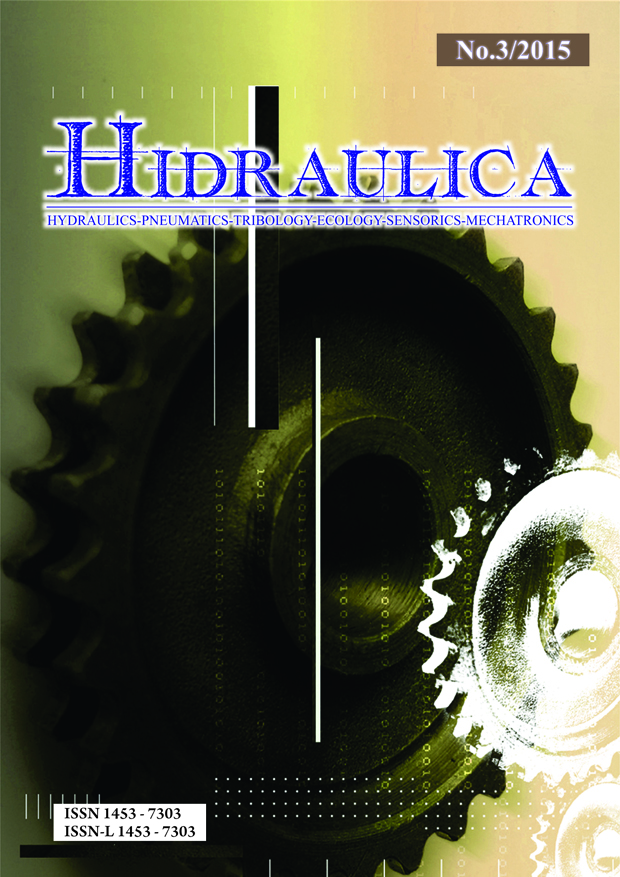Configurations of the Flow Induced by a Fan Impeller without Casing
Author: Andrei DRAGOMIRESCU
This paper presents a study of the turbulent, compressible air flow induced by a fan impeller without scroll casing. The equations governing the flow – continuity equation, momentum equations, energy equation and the equation of state – were solved numerically using the finite volume method. The Reynolds Stress Model was used to provide the closure equations. Different simulations were made by changing the overpressure imposed as boundary condition at the outflow. The overpressure was varied stepwise between the choke limit and the limit corresponding to reversed flow. Despite the symmetry of geometry and boundary conditions, the results obtained indicate the appearance of non-axisymmetrical solutions. Moreover, two bifurcating solutions were obtained at certain operating points. These solutions are characterized by two and, respectively, three dominant directions of the flow outside the impeller. By dominant directions we denote … (read more)
A Review of Design of Stirling Engines
Author: Sunny NARAYAN
This work provides a review of n solar-powered Stirling engines devices. Previous works have focussed on the solar powered as well as low temperature differential engines. The aim of this work is to review working fluids for operation of this engine. Air was found to be a good alternative as a working medium for … (read more)
Liquid Film Adhesion in Contact between Rough Surfaces
Authors: Amir ROSTAMI, Jeffrey L. STREATOR
Many micro and nano scale devices are influenced by the presence of liquid at the interface between contacting surfaces. Such liquid may induce large and undesired adhesive or “stiction” forces. In some cases, liquid may find its way into the interface of two rough surfaces that are already in contact. It is of interest to model the manner in which the interface proceeds to a new equilibrium configuration upon introduction of the liquid. Such a process involves interactions among viscosity, elasticity and capillarity. To simulate such effects, a contact model is employed to account for … (read more)
Heat Transfer Performance Analysis in Porous Heat Exchanger
Author: Petre OPRIŢOIU
In the case of electronic components cooling, out of many ways and variants of existing heat transfers, the fluid single-phase forced convection heat is an effective and widely practiced method, especially due to its simplicity and economical character. In order to allow the evacuation of increasing heat fluxes, the method was optimized by making special heat exchangers, more and more compact, as meso-channel, micro channels [1] and more recently the porous metal heat exchangers [2,3].
The objective of the research is to obtain a functional relationship between the cellular structure of open-cell metallic foam and the heat transfer characteristics for forced convective flows. Ideally foams would simultaneously maximize the amount of heat transfer and minimize the pump power needed to … (read more)
Experimental Investigation on Transient Response of Two Stage Pressure Relief Valve
Authors: Basavaraj V.HUBBALLI, Vilas B.SONDUR
Pressure control valves are used in fluid power systems to control the operation of the hydraulic system. The time response of a hydraulic system is the integrated result of the response times of all of the components used in the system. The ability to understand and manage the valve performance characteristics like transient response, pressure-flow are important in automation and heavy industrial processes. In this paper, part of experimental research work … (read more)
Experimental Methods Aiming to Improve Dynamic Performance of Pneumatic Actuators
Authors: Gabriela MATACHE, Gheorghe SOVAIALA, Radu RADOI
This paper presents the tests carried out on two dimensional types of pneumatic actuators to determine their dynamic characteristics, highlighting the main factors and methods influencing them. The paper presents only three of the tests that have been conducted on actuators. They are:
– response to step signal in three points of the stroke, at constant pressure – 8 bar;
– response to sine wave signal having initial amplitude, from minimum to maximum value, for three stroke values;
– determining the minimum starting pressure for … (read more)
Influence of Cutting Parameters on Surface Roughness of Red Brass (C23000) in Turning Using Exponential Model
Authors: M. Hanief, M. F. Wani
This paper examines the effect of cutting parameters (cutting speed, feed rate and depth of cut) onto the surface roughness of red brass during turning. Mathematical model was developed by using experimental data gathered from a series of experiments, based on full factorial design. The experiments were performed on red brass using HSS tool. Exponential model based on regression analysis were developed in this study. It was concluded from the study that … (read more)
Flow through Command Hydraulic Resistance
Authors: Ioana SFARLEA, Lucian MARCU, Daniel BANYAI
The growing usage of hydraulic servo technique involves optimizing the elementary components of these types of devices. The paper presents the results of a study on hydraulic resistance, achieved by mathematical modeling and numerical simulation, CFD. We have studied three types of bushings and 3 types of piston forming different geometric resistant fed in turn with three different pressure values. There are shown the formation and dissipation of fluid jets that appear in … (read more)
Study on the Dynamics of the Tilling Aggregate
Authors: Cristian NUȚESCU, Iulian-Claudiu DUȚU
This paper has as main subject presenting some theoretical and experimental researches regarding the dynamic behaviour of the tilling aggregates. These are made of a tractor and an attached plow that allow emphasizing the influence of … (read more)
